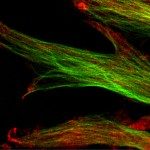Lien vers Pubmed [PMID] – 16627468
J. Biol. Chem. 2006 Jun;281(25):16914-26
The adenylate cyclase toxin (CyaA) is one of the major virulence factors of Bordetella pertussis, the causative agent of whooping cough. CyaA is able to invade eukaryotic cells by a unique mechanism that consists in a calcium-dependent, direct translocation of the CyaA catalytic domain across the plasma membrane of the target cells. CyaA possesses a series of a glycine- and aspartate-rich nonapeptide repeats (residues 1006-1613) of the prototype GGXG(N/D)DX(L/I/F)X (where X represents any amino acid) that are characteristic of the RTX (repeat in toxin) family of bacterial cytolysins. These repeats are arranged in a tandem fashion and may fold into a characteristic parallel beta-helix or beta-roll motif that constitutes a novel type of calcium binding structure, as revealed by the three-dimensional structure of the Pseudomonas aeruginosa alkaline protease. Here we have characterized the structure-function relationships of various fragments from the CyaA RTX subdomain. Our results indicate that the RTX functional unit includes both the tandem repeated nonapeptide motifs and the adjacent polypeptide segments, which are essential for the folding and calcium responsiveness of the RTX module. Upon calcium binding to the RTX repeats, a conformational rearrangement of the adjacent non-RTX sequences may act as a critical molecular switch to trigger the CyaA entry into target cells.
